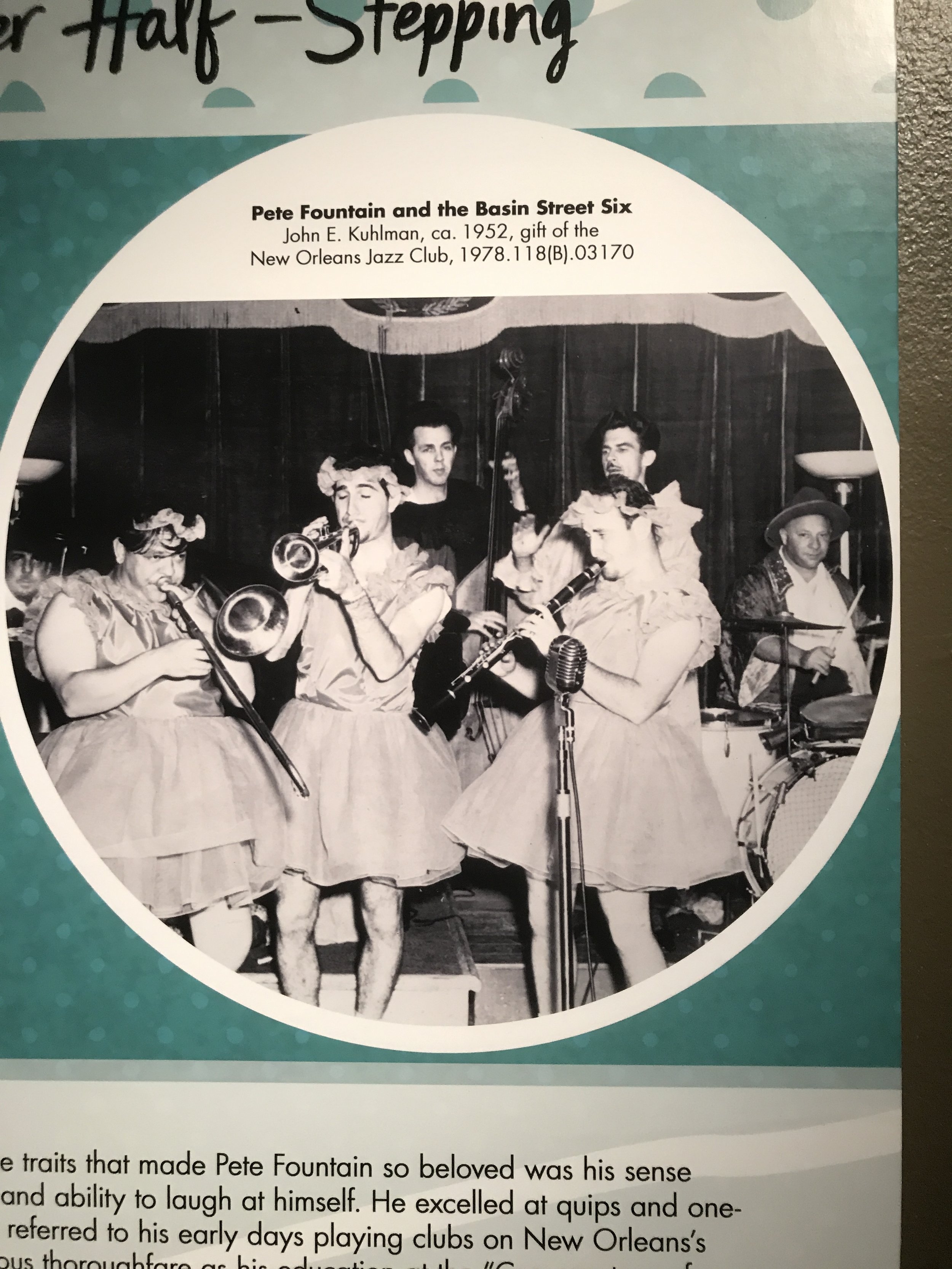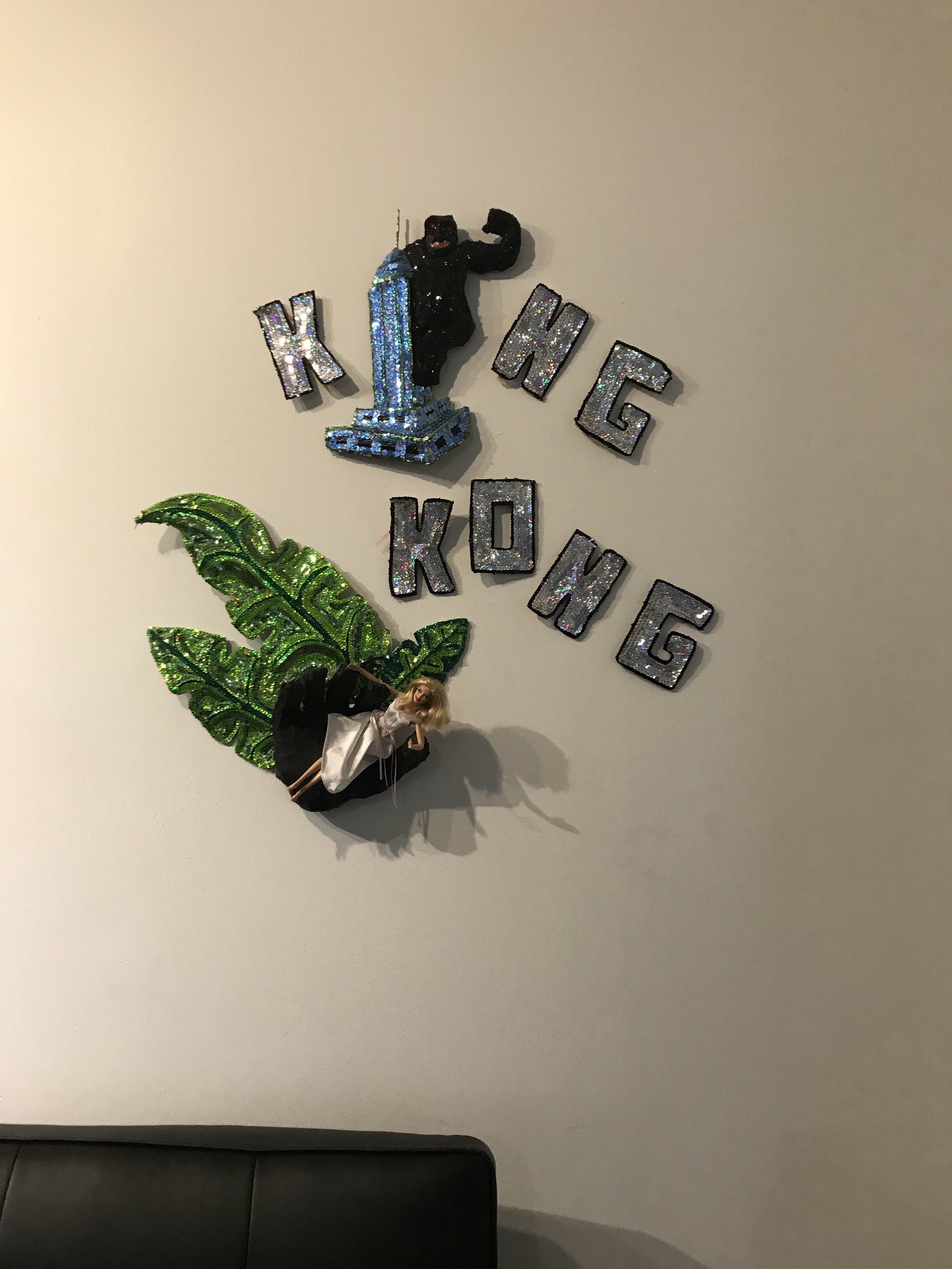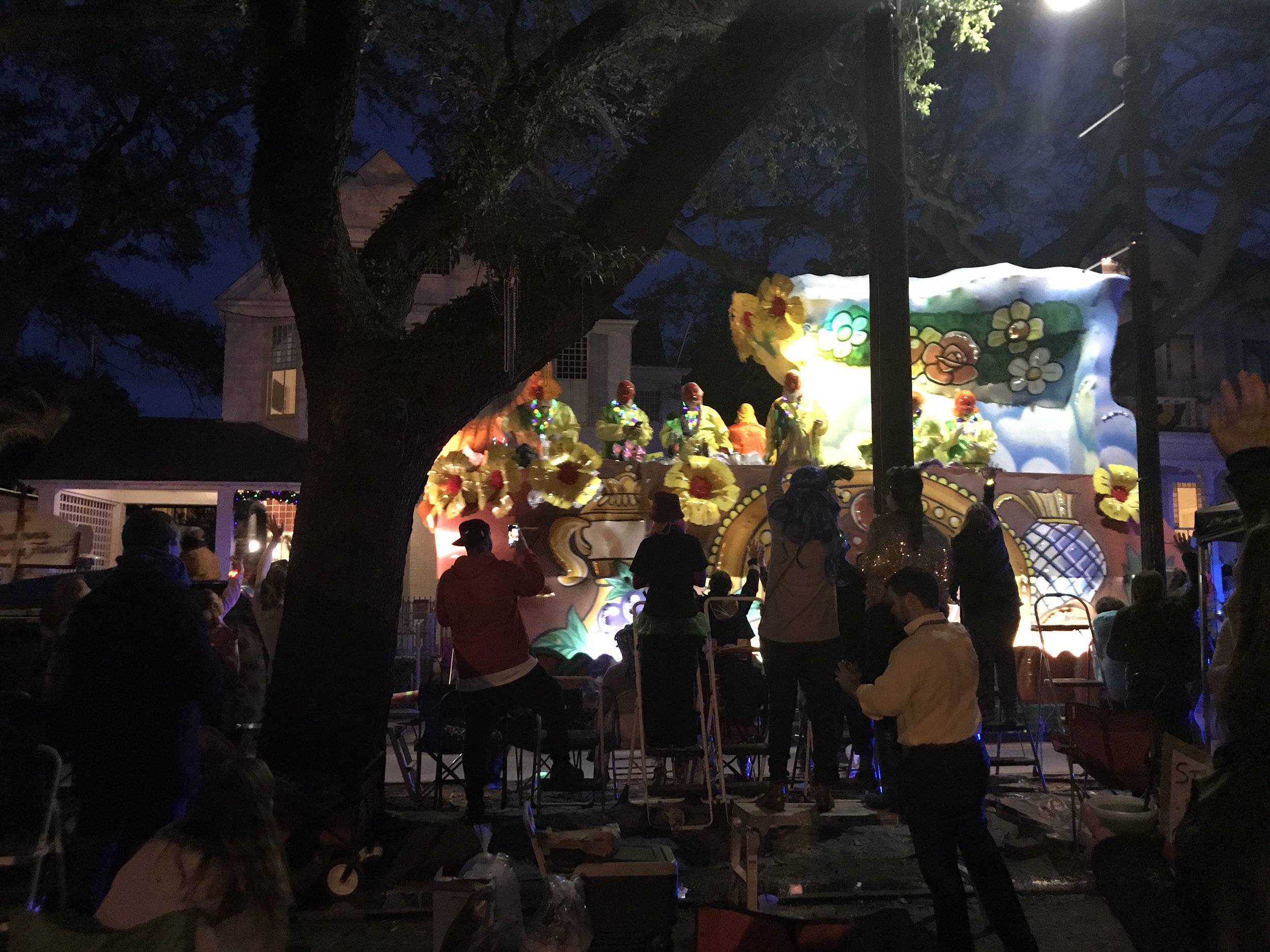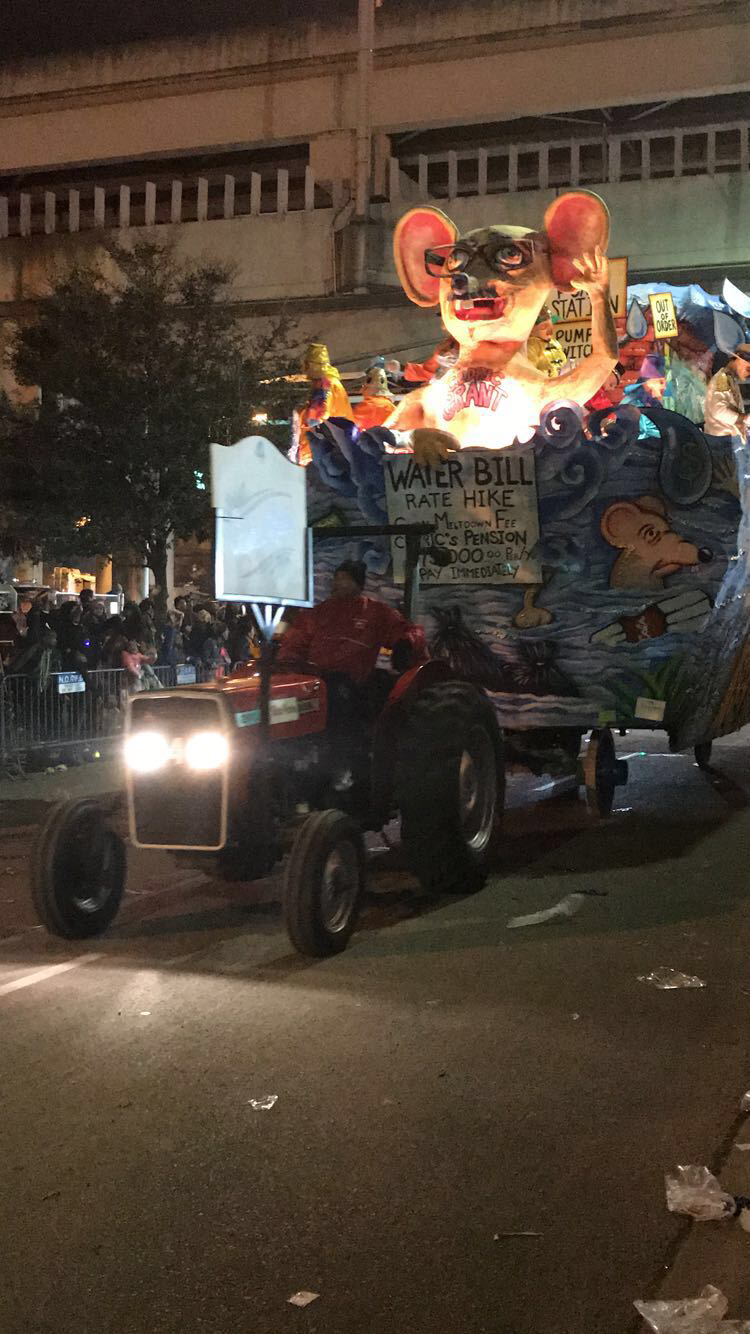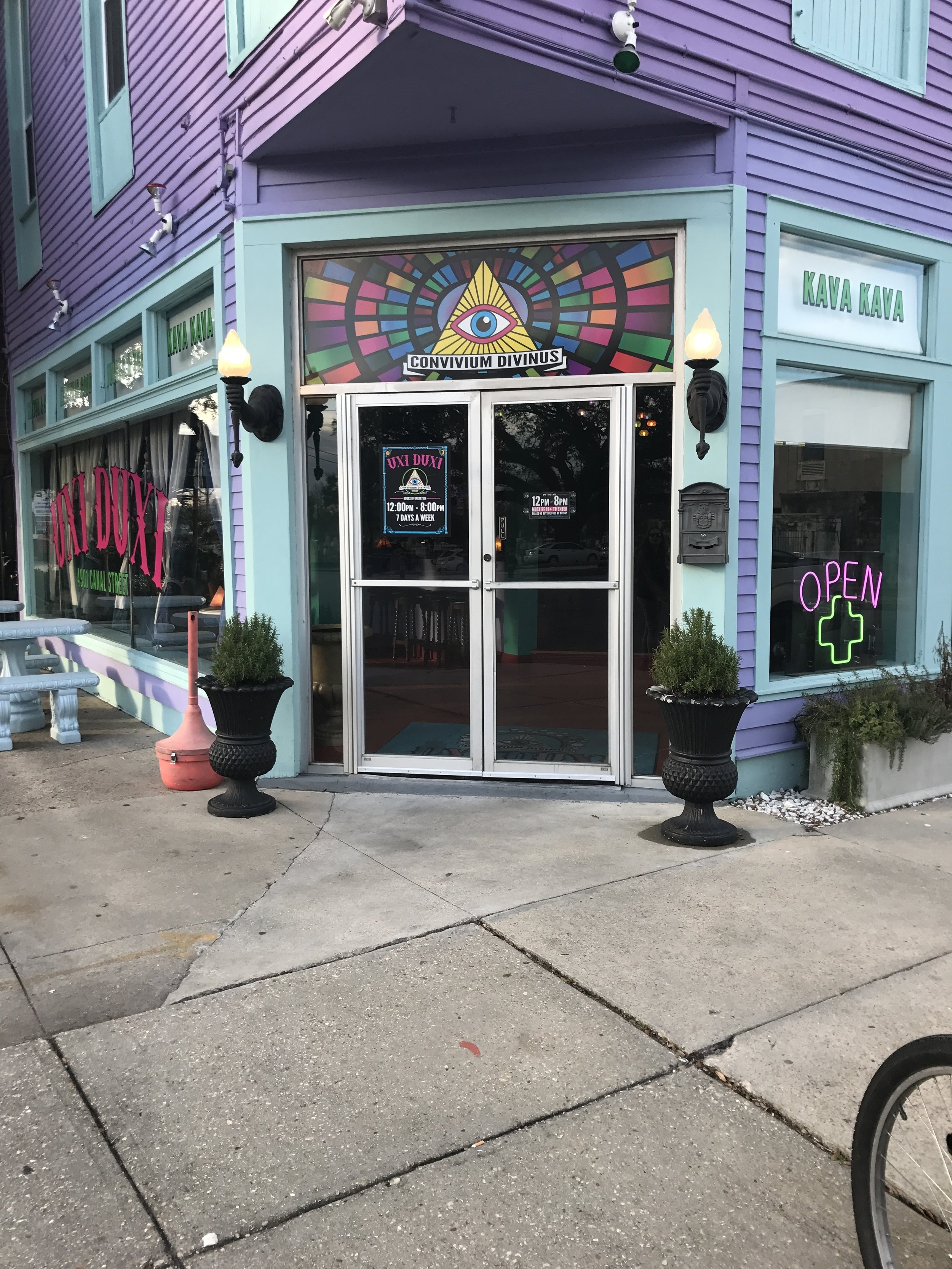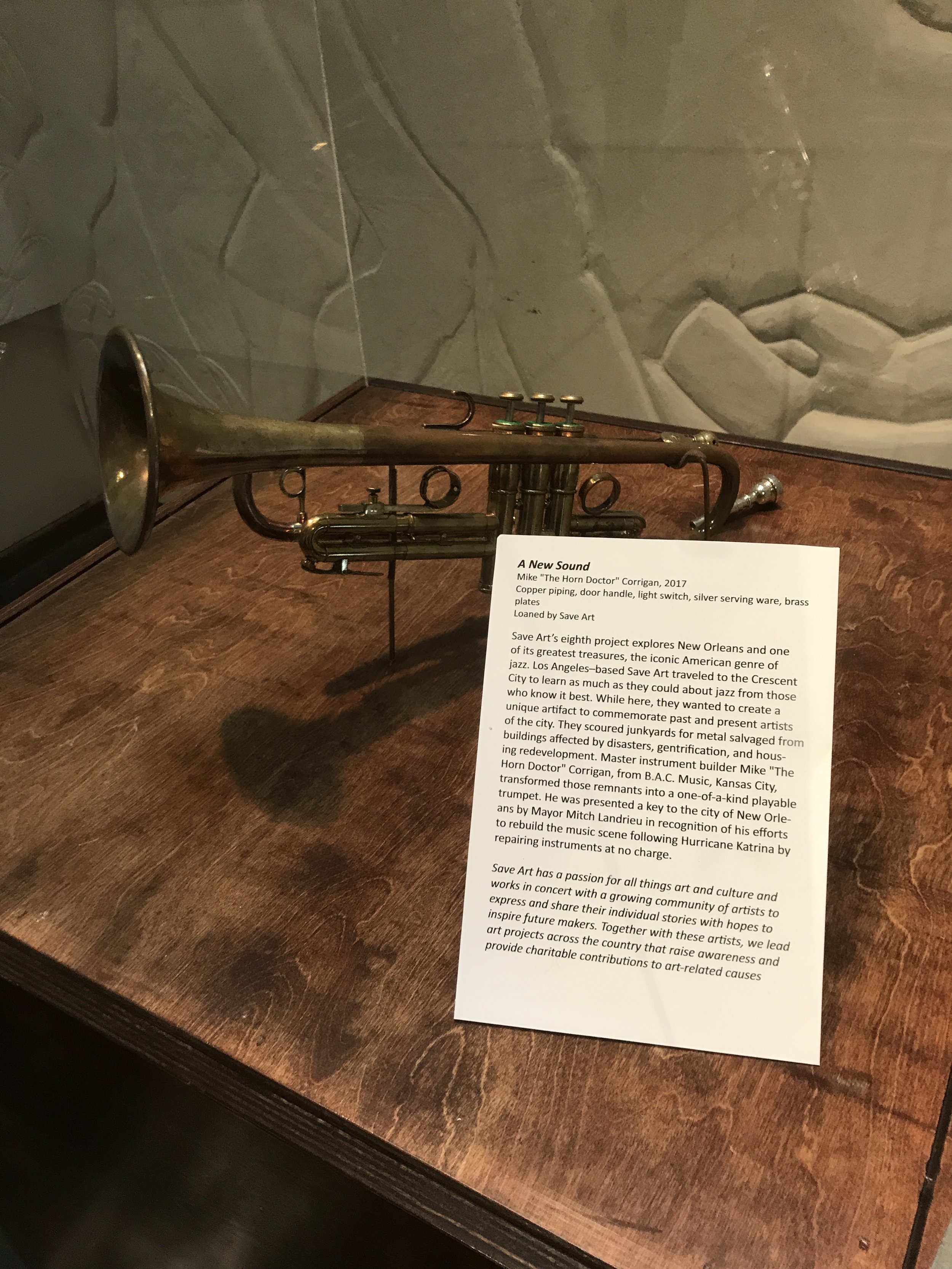NOLA Day 4- Costumes, Collages, and Crazy Parades
Today started with a trip to possibly New Orleans' most famous cafe, Cafe Du Monde. Along the way there our Lyft driver did a flawless Dave Chapelle impression and also said that he was worried about Kanye West because he felt like he was "in the sunken place". It was a pretty great start to the day. The cafe itself also completely lived up to it's reputation. Dating back to 1862, Cafe Du Monde is a staple of the French Market, specializing in old fashioned coffee with chicory and beignets, French doughnuts with powdered sugar instead of holes. It's one of the rare places in the French Quarter that might be equally popular among locals and tourists because it's just that damn good. You might have to wait in line, and you'll definitely have to pay in cash, but it is worth it. The coffee is excellent, and the beignets are like if someone somehow found a way to make fried dough even better. It's gonna make regular doughnuts hard to go back to.
After breakfast, we sort of ambled along the French Market area, poking into neat little shops and admiring all the art and music everywhere. In particular I was really loving these public fountains:
Our next official stop of the day was the New Orleans Jazz Museum. One of the cool things about the museum is that it was in the Old U.S. Mint so you got a little bit of State and Federal history thrown in with your Jazz. The first exhibit we looked at was all about the Old Mint. They had all the vintage machinery, including coin presses, counters, and sorters. I like that the old coin bags actually look like cartoon money bags, even though they said $1000 not just $$$. It was a fun window into a different time, when money was a little less standardized and coin designs carried stamps of where they were made. It was also cool because it was one of the few federal mints that got taken over by the Confederacy os it had produced both US coins and Confederate coins. The minting of confederate coins only lasted for a month though, because they ran out of gold and silver which gives some indication of the dire economic situation of the South during the war. Naturally because there were so few and they're so rare, those confederate coins are worth a fortune today.
My favorite coin related fact about the mint though was that they had actual buried treasure. In 1865, USS Republic sunk carrying thousands of Gold and Silver coins from New York to New Orleans. For years people searched for this long lost treasure, but it wasn't found until 2003 when it was finally uncovered off the coast of Georgia. I don't know what happened to all the coins, but a pretty decent cache of them ended up here which was super cool to see. My favorite non-coin related thing in the mint was an old Violin that belonged to the leader of the Mint employee's own orchestra. I liked that because I love that because it's hard to imagine a bunch of office workers deciding to start an orchestra together nowadays, and also because it sort of tied the mint section back in with the rest of the Jazz museum.
After the mint, the first jazz related exhibit we saw was a series of photographs by Sekou Fela capturing large street gatherings from the 1960s to today. THese include funerals, parades, civil rights marches, Black Lives Marches, and Marching Bands. One of the biggest constants throughout these tonally different gatherings was the presence of music in some capacity, and it was really cool to see how intimately entwined music is with so many facets of the human experience. I also got a kick out of seeing some pretty big names in the old photographs of civil rights marches including one of the greatest jazz drummers of all time, Max Roach. Max actually had a pretty big history of activism to go with his musical accomplishments so he was really an all around bad ass.
Up the stairs to the main floor of exhibits, we learned that the Jazz Museum was also participating in Prospect 4 when we were greeted in the lobby by a large sculpture by an artist named Rashid Johnson. The sculpture called "Fiend" looks bulky, but it's collection of plants, vinyl, and found objects is actually one giant microphone with speakers for guests to interact with, so it's really all about messing with perceptions.
The next exhibit was also part of P.4 and featured the works of Big Chief Darryl Montana. It is a Mardi Gras tradition among the Black community in New Orleans for different neighborhood groups to have competitions in the art of Indian masking. Elaborate suits are made and different roles are assumed from the Big Chief to the Spy Boy, and the highest honor is to be the prettiest chief. This tradition is in the blood of the Montana family with Montanas leading Indian masking from the first time it appeared in Mardi Gras in the late 1800s and passing on costume making traditions from generation to generation. The idea of dressing up like Native Americans has come under a lot of scrutiny lately with many white college students (deservedly) getting into trouble at Halloween parties but this is a very different tradition. Whereas Halloween costumes relegate real cultures to the same status of werewolves and vampires, Black Indian masking at Mardi Gras has a more interesting and complex history. In the early days of New Orleans, Native Americans would sometimes help slaves escape by dressing them up as members of their tribe. Thus the tradition is actually a celebration of solidarity amongst two oppressed groups, and the flamboyant "costume"-like affectations are not to denigrate the Native Americans but to celebrate Black creativity and freedom that the Native Americans helped give them. It's a really fascinating history that's so tied to New Orleans' special hodge-podge of different indigenous and colonial groups co-existing. Even if the historical and social context wasn't so cool to learn about, the suits could just stand for themselves as works of art. Intricately combining feathers, beads, pearls, and sequins, Darryl Montana's suits are massive, colorful, and jaw-droppingly pretty. The tradition becomes even more impressive when you realize that some of these suits weigh over 100 pounds, and they people wearing them not only have to parade in them, but they've gotta dance. It's just amazing.
The next wing of the museum was back to the jazz featuring a special exhibit celebrating the long, storied, and frequently overlooked history of women in Jazz. This exhibit was really awesome, celebrating famous greats like Bessie Smith, Ella Fitzgerald, and Billie Holliday as well as more recent artists like Helen Gillet, Lillian Boutte, and Debbie Davis. The museum had a mix of donated instruments, photographs, and most importantly listening stations loaded with audio files of these women doing their thing. From the very beginnings of jazz, women were there in every capacity leading, supporting, inspiring, and not infrequently outdoing their more famous male counterparts, and jazz as we know it today could not exist without their contributions so it was nice to see them getting the shout outs they deserve. The thing I was most surprised by were the hand painted instruments of Charmaine Neville sister and frequent accompanist of her brothers Art, Cyril, and Aaron of the Meters and Neville Brothers fame.
Just beyond the women in jazz exhibition was more P.4 artists. The first works were by an artist named Peter Williams who created rich densely populated paintings filled with overlapping abstract shapes, cartoon figures, and carefully chosen words. The works in this exhibit frequently featured grotesque and racially charged imagery to comically exaggerate poor history of race relations, including two paintings of white folks eating black folks. I loved the way the paintings blended high and low art with truly impressive cosmic and abstract imagery with much more cartoonish characters.
My favorite piece by Williams was entitled "Bitches" and I love the way different figures and faces emerge out of the swirling brushstrokes.
The next P.4 artist was named Rivane Neuenschwander and she made an incredibly clever video of ants after carnival celebrations in her native Brazil as they collect various pieces of confetti and left over celebration materials and try to bring them back to their nests. There's something both deeply comical and alarmingly allegorical about watching the ants clamor over the confetti which both amusing large relative to their bodies and also so useless for them. But how would they be able to know that? They just assume all that random junk has to be there for some reason.
The next artist, Satch Hoyt, created sculptures using tambourines and two mirrors to make it look like the drums made a chain to infinity. It was pretty surreal, but I had a tough time taking my eyes off it.
The next artist's work was more of a proof of concept, because the full project hasn't been realized yet. Spanish artist, Maider Lopez, planned an elaborate project called Under the Walls that seeks to replace brand name insulation on newly constructed houses with more artistic representations like the example below.
The next exhibit featured instruments of New Orleans jazz legends, and included Fats Domino's piano, Dr. John's piano, and Louie Armstrong's first cornet. It was pretty astounding to be surrounded by the tools of the truly great.
After this exhibit was a special feature on recently deceased local hero, Pete Fountain. Pete was an acclaimed Jazz clarinetist, playing nightclubs since his teens, appearing in the Lawrence Welk orchestra, and eventually opening up his own jazz club that brought lots of big names including Frank Sinatra down to the Big Easy. He was also a larger than life personality known for performing drunk at Mardi Gras with his buddies in the Half-Fast (say it quick) Walking Club, playing in drag, sending funny Christmas cards, and even getting a stomach tattoo at the tender young age of 70.
The next P.4 artist was a real surprise, because it was none of other than Louie Armstrong. Apparently besides being an incredible trumpet player, Louie also throughout his life made over hundreds of tape recordings of ambient sounds and on the back of these tape boxes he would make collages using photographs, press clippings, and ephemera. He made hundreds of these collages, and never really talked about them or explained why he made them, and there's something incredibly wonderful about that. The jazz museum and the P.4 curators obtained about 20 of these collages and the rest of the vast collection is located in the Louie Armstrong House Museum in New York. These were really a trip capturing a whole new side of a well known icon. They have an improvisational feel to them akin to his music and frequently feature imagery of Armstrong himself leading academics to suspect they may have been his way of taking ownership of his own celebrity. That being said, trying to interpret the collages is half the fun, so one single narrative can't quite be pinned down.
My favorite collages were Louie's tribute to Belgian surrealist collagist Carlos de Radzitsky with a beautiful array of seemingly random imagery, a collage featuring, and I'm quoting from the exhibit guide, "his favorite natural laxative", and a collage featuring a just incredibly weird photo of him holding a plaster cast of his own face.
This wing continued with the works of Kenyan artist Michael Armitage, who made oil paintings on traditional bark cloths from Uganda called Lubugo which give his painting beautiful and unusual textures. They were really dreamlike and colorful, and really evocative of a sense of hazy memory.
The next artist really blew me away with the diversity of his works. Dario Robleto's specializes in using non-traditional materials in poetic ways and his piece American Seabed features mounted butterflies on fossils of whale ear bones with antennae made out of magnetic tape cut from Bob Dylan's Desolation Row. I think the intent is to link through something beautiful (the butterfly) a very classically american music to a primordial form of hearing. That's all a bit over my head but it sure is neat to look at, and delightfully weird that someone put it all together.
Robleto's next piece was slightly more traditional but nonetheless impressive. Entitled Goodbye Babylon (remix), Robletto partnered with Lance Ledbetter and April Ledbetter of Dust to Digital Records to design layouts and presentations of their music packaging. Dust to Digital specializes in preserving and enhancing old, old recordings of folk music and field recordings from around the world. Goodbye Babylon is their 160 song collection of early American church music, and it encompasses birth of rock and roll, blues, and country music traditions. They had several listening stations and it is just amazing, and the packaging Robletto devises with woodcut cases and fold outs is equally stunning. Also included was another display of a Dust to Digital collection highlighting the works of an artist named Washington Phillips. In the 1920s, Phillips was a preacher and he made recordings with a home-made instrument called a Manzarene which was like a two-headed zither that created really bizarre ethereal music that his powerful voice just floated over. He only made a few recordings on wax cylinders over a span of two years, and they were nearly lost to history but now they have this beautiful box set with incredible collaged art from Robletto. I think that's a really beautiful turn around.
The last P.4 artist in the museum was a London based artist named Larry Achiampong, whose video Sunday's Best explored faith and contradictions in the Christian diaspora among Ashanti people in London. The video was really lovely, but I think we were a little worried that if we sat down too long we might fall asleep so we decided to head out and grab some lunch and coffee.
On the way out though we discovered that there was one more P.4 artist just outside the museum with incredibly whimsical sculpture by Hank Willis Thomas of a young knight gallantly riding a giant snail. I love that we got to experience this city-wide art project.
For lunch, we went to a cool restaurant called Green Goddess, that was known for being a good spot to get some vegetarian food since my sister's had to suck it up and eat a lot of appetizers at other restaurants this week so she was overdue for a real meal. The Goddess did not disappoint. My sister got mushroom biscuits and gravy because this was southern vegetarian cuisine meaning it was still gonna be comfort food and damn good comfort at that. The biscuits were made out of sweet potato and it came with truffle oil grits. She loved it. As for me, I got essentially the same thing but with boudin, a cajun sausage made out of pork and rice, instead of the mushrooms and gravy. I can confirm the biscuits and grits were phenomenal, and I had never had a sausage with a rice component before but it gave it a really interesting and lighter texture that I was pretty into. We also each got coffees so that we would have the energy to keep going to our next stop.
Our next stop was the Mardi Gras Museum of Costumes and Culture, which our first Air BnB host referred to as his museum because his Mardi Gras King costumes and photos are prominently featured.
Hollis' museum did prove to be quite a treat featuring all kinds of different Mardi Gras costumes and props, including more Black Indian suits, giant heads, Elvis, Pinocchio, the MTV astronaut from back when that was still part of their logo, a Moss Man suit, outfits from the Ordinary Men Walking Club, and obviously giant clam shells. The whole museum was really an explosion of color and creativity, and I love how much craft, artistry, and love goes into making these lavish and outlandish costumes every year. Mardi Gras is free of corporate sponsorship so these groups aren't making money (though some do take up donations for charity) which means that they're all in it for the love of the game and the cultural tradition. It's a really unique and beautiful thing that doesn't really exist outside of NoLa.
The special exhibit while we were there had the incredible title Goddesses in Bodices and showcased the handiwork of the Dames de Perlage. The dames are an all female krewe that are known for their hand made beaded bustiers and headdresses. The beadwork was astonishing with each dame repping a different "saint". The saints could be playful like St. Ignatius of A Confederacy of Dunces or more genuine such as the loving tributes to the recently departed Fats Domino and Allen Toussaint. I'm just impressed at how well the dames are able to capture actual likeness and scenes through beads. Actual photographs of Dames wearing their handmade bodices really show off how well made they are because they are drinkin', dancin', and having a grand old time and they don't lose a bead!
There was also a costume corner so my sister and I naturally dressed like giant flamingoes. Her flamingo looks a lot tougher and mine looks a lot dopier, and I think that's pretty fair.
After the museum, we walked around Louie Armstrong Park which also contains historic Congo Square. In early New Orleans, Congo Square was one of the few spaces in the city where enslaved people were able to congregate, socialize, sing, dance, and trade with one another, and it is considered one of the largest birthplaces of many African-American musical traditions. It was a cool historical part of the park, and there was also the added benefit of it being a beautiful day to just be outside. The park was also filled with some pretty impressive sculptures of famous New Orleanians.
My favorite statues were of the big man himself, Louie Armstrong, and a really cool tribute to Buddy Bolden that used bright colors and a fractured design to really wonderfully captured the beauty he created despite his own complicated mental state.
After all that being outside and walking around stuff, we were in need of another coffee. We went to a cool coffee shop located near several of the famous cemeteries called Sacred Grinds. They leaned into the spookiness of their location even having their own Zombie Jesus. I really liked the vibe their because the barista was really nice and they were playing Donuts by J Dilla. Between that, the great coffee, and all the voodoo and zombie paraphernalia I was pretty happy with our choice.
The cemeteries were starting to close by the time we got there, but we still had a little bit of time to walk around and admire all the tombs. As I mentioned earlier in the week, the dead are not buried underground in New Orleans because with the extremely wet soil, if they were they wouldn't stay buried for long. Instead they are laid to rest in tombs, vaults, and crypts which make for much more visually exciting cemeteries than the average tombstone.
Tonight was our night to go actually see a Mardi Gras parade, but we had a little time to kill so I wanted to walk and get some more food now because I wasn't sure if it would be easy (or cheap) to come by during the parade. We walked past the cemeteries to a local favorite called Parkway Bakery and Tavern, where Obama ate when he visited the city. Their specialty is their po boys, and I had a tough time deciding between their roast beef and their shrimp so I didn't. I got the Surf and Turf which had slow cooked roast beef topped with Louisiana wild caught gulf shrimp smothered in gravy. It was incredible with big fat juicy shrimp and perfectly cooked savory roast beef on an amazing baguette. It's up there for the best sandwich I've ever had, even if I ended up getting that gravy all over myself. And it was under $10! Lauren was still full from lunch so she didn't get anything, and instead chose to document me being a disgusting pig. I think in in one of those pictures you can see me unhinge my jaw to attempt to cram even more food into my gaping maw.
After dinner, it was Mardi Gras time!. Tonight the Krewes of Baylon, Chaos, and Muses were parading. The whole city for miles was a big party. There were elaborate floats, marching bands, beads being thrown, and liquor flowing freely. Lauren and I got hurricanes to start with because that was a New Orleans drinking tradition we hadn't participated in yet. We also happened to bump into a woman selling $1 jello shots out of a basket little red riding hood style so we each got one of those as wells, and rest assured we were decently warmed up to enjoy the parade from them on. We got there early enough that even though there was a big crowd it was still possible to get close enough to catch the eyes of the Krewe members giving out throws. We caught beads, drinking cups, and weird light up things. Some of the krewes also have signature throws. I couldn't tell if Babylon or Chaos had ones, but I knew that the Muses' signature throw is red high heeled shoes which are a real prize if you can catch one. It was so much fun, and we alternated between camping out and following the parade route so that we'd eventually be closer to downtown. There was just so much excitement to take in from every direction. In particular, I gained a lot of respect for the babies of New Orleans because there were loud noises and bright lights everywhere, and more than once I saw one get tapped on the head by some flying beads, but not once did I see one cry. I guess those Mardi Gras Babies are made of tougher stuff than the babies up north. Other big highlights of the parade for us were seeing all the school marching bands. They ranged from elementary school to high schools (maybe colleges on some parade days, but we didn't see any) and they were uniformly excellent. The younger bands really stood out not only because they were so good so young, but also because half the kids were smaller than the instruments they were playing and it was exceedingly adorable. My sister and I both played in our high school's marching band, and we good for our region but we had nothing on these kids. It's really great to see that there school district must actually be putting some money into their arts education. One of the other things I got a big kick out of was some of the dancing groups, including one group of women all dressed like air plane stewardesses and doing a choreographed routine whenever the parade stopped to show off.
Unfortunately we never got to see the headliners because right when Chaos was ending and Muses was about to begin marching, gunshots sent the whole place into disarray. Luckily we found out later that it was just some drunk teenager firing a gun in the air to celebrate and nobody was hurt, but in the moment it was pretty scary. I'd never seen a police horse actually charge into action before and seeing how fast it moved in a street that was too crowded for cars, the whole mounted police thing only just then actually made sense to me as a thing we still need. My sister and I also learned we don't have the greatest survival instincts in the world because when people started running we just stood there because we didn't want to lose our sick parade-viewing spot. Lauren gets a few more points over me though, because she at least realized what had happened, but until she told me it was gunshots I just assumed the noise had been part of the whole thing.
The parade ultimately did continue but it paused for a bit while the police did their work, so we decided to bail and go to my sister's favorite part of the city from when she went there in college: Frenchman Street. Frenchman is full of cool bars, music, and art and we enjoyed all three. We started in a bar called The Spotted Cat where we watched some good old fashioned New Orleans jazz bands lay down some funky tunes. and knocked back some drinks.
The band was great but eventually the exploring urge took us, so we took our drinks (because no open container laws) and hit the town. We walked around a really cool outdoor artists' market, and I had a really nice and geeky conversation with one of the artists about his drawn portraits of MF Doom, and I bought one to give to my little cousin as a present for finishing boot camp. I didn't take any pictures though despite all the great art because they had a sign that said "Absolutely No Fucking Photos" by the entrance which I took to mean that they weren't big fans of photos in the market. It makes sense though when they're actually trying to make a living off the stuff I guess.
After the market, my sister and I parted ways because she wanted to get a tattoo while she was down here, and she found a good spot with good prices that was open late so she didn't want to miss the chance. While I waited I got to bar hop.
I started in a bar called the Dragon's Den. Earlier they had had a comedy open mic, but all the comedy had cleared out by the time I got there. Instead there was a really cool band there called Felion playing experimental jazz fusion that blended in metal, hip hop, and classic rock in with their jazzy sound. The band consisted of bass, drums, guitar, and sax/vocals, and everyone was insanely talented taking solos to fun, weird, musically strange places even when covering Lenny Kravitz's I Wanna Fly Away. It was a trip, plus I found out that my bartender was also a Massachusetts native so I bonded with her about that in between songs which was nice. It was also sort of freeing not having comedy or a drive to do that night so I could actually get good and drunk for one of the first times in this trip. I wasn't going as hard as some of the other people in the bar though, because when I went into the bathroom I saw a 50 year old man doing coke off the blade of a knife. Now I would not have said yes, but I feel like it would have been the polite thing for him to do to offer me some. Some people are just rude.
After the dragon's den, I floated on down to a place called Dat Dog which specializes in hot dogs and strange hot dog related imagery. I wanted drunk comfort food though and hot dogs in the moment gelt like too much meat so I ordered the crawfish etouffee fries. In hindsight that's a way weirder choice, but it felt festive and also tasted amazing. The etouffee sauce gave a nice zing to the fries and there was actually a pretty decent amount of actual crawfish. I also found an IPA, I actually liked, the Port Orleans Brewing Co. RoyalTea. It was infused with Earl Grey tea which kind of mellowed out the hoppiness. I'm sure the four or five other drinks that night probably didn't hurt the taste of that one either.
At some point most of the way through the fries, my sister and her new tattoo found me and we got a Lyft home to turn in after a pretty eventful night. It was more than a little shocking to see just how many beads we and things we had actually caught and been walking around with the whole time. Some silly prizes for a night of very silly behavior.
Favorite Random Sightings: A sign on someone's porch that said "Beware of... Well Just Beware"; Mo' Pho; Big Doink Crew; A band called Soltree
Regional Observations: New Orleans reminds of me Nashville in that when bands are playing at bars they're actually really, really good, not just Bon Jovi cover bands
People's Favorite Jokes: None today but here's one from the internet:
A blonde came up to the librarian & yelled, "This book sucks! There's way too many characters & the story makes no sense!" The librarian said, "So you're the one who took our phone book."
Songs Of the Day:
I believe that is scientifically as sexy as the clarinet can be
I'm sad to say I'd never heard of her before the women in jazz exhibit but what a powerhouse
In case you were wondering what his homemade Manzarene sounded like
They were honestly so cool live












































